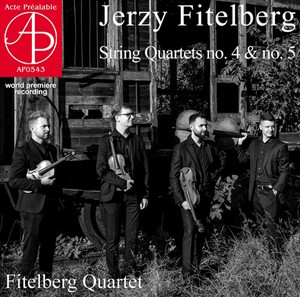
Jerzy Fitelberg (1903-1951)
String Quartet No.4 (1936)
String Quartet No.5 (1945)
Fitelberg Quartet
rec. 2022, Concert Hall of the Music School, Jastrzębie-Zdrój, Poland
Acte Préalable AP0543 [61]
The ARC Ensemble recorded the first two string quartets by Jerzy Fitelberg on Chandos eight years ago, part of a ‘Music in Exile’ series (review) that focused on a variety of his chamber music. Now here are the Fourth and Fifth Quartets played by the quartet that has taken the composer’s name. If the first two quartets, written in 1926 and 1928, wore their Stravinsky-and-Francophile affiliations proudly, these later works are somewhat thornier.
In 1936 he was living in Paris, having left Germany where he’d lived for many years and where he’d studied with Schreker. His Fourth Quartet uses one of Fitelberg’s favoured forms, a Theme and Variations; in this case, a Theme and seven variations with a concluding fugue. It’s a strikingly angular Theme with contrastingly smoother elements – comparatively speaking. He builds through the variations with inexorable logic, drawing on a range of influences, including that of Stravinsky, whose influence had permeated the first two quartets. There are some ecclesiastical-sounding moments, a lot of Bartók-like rhythmic vitality and near-folkloric barbarity. Fitelberg varies the dynamism of the variations well, ensuring that there are moments of reprieve, his shifting thematic writing at times daringly spare. He unleashes a fugue to end the work with darting, restless clarity, music of sophisticated assurance. Each variation is separately tracked.
The Fifth Quartet, Fitelberg’s last, comes from his American phase. He’d fled there early in 1940, living in New York until his early death in 1951; he suffered cardiovascular disease which led to a fatal heart attack. Though it was written about a decade after the Fourth, it shares a similar conception, this time an opening Allegro followed by a Theme and five variations, topped not by a fugue but by an extended Vivace finale. There’s a lot of intervallic inventiveness in this work and there’s rather more ‘air’ to it than in the more clotted earlier work. Similarly, though superficially similar the variations are both terser and crisper than in the Parisian Fourth – there’s a lightness, an almost-humorous slant to them that’s cemented by the ripely unfolding finale, that has genuine intensity but not the convoluted exposition of No.4.
These are apparently world premiere recordings and were well recorded in a concert hall setting in July 2022. The Fitelberg Quartet really digs into the variations but relishes the lighter elements of the music as well. They have august forebears. The Fourth Quartet was premiered in 1937 by the Coolidge Quartet and the Fifth in 1946 by the Hungarian. It would be good to think that other ensembles will take up Fitelberg’s chamber music and the larger musical world will realise that there are two Fitelbergs to consider – the conductor Grzegorz and his son, Jerzy.
Jonathan Woolf
Help us financially by purchasing this through MWI



















